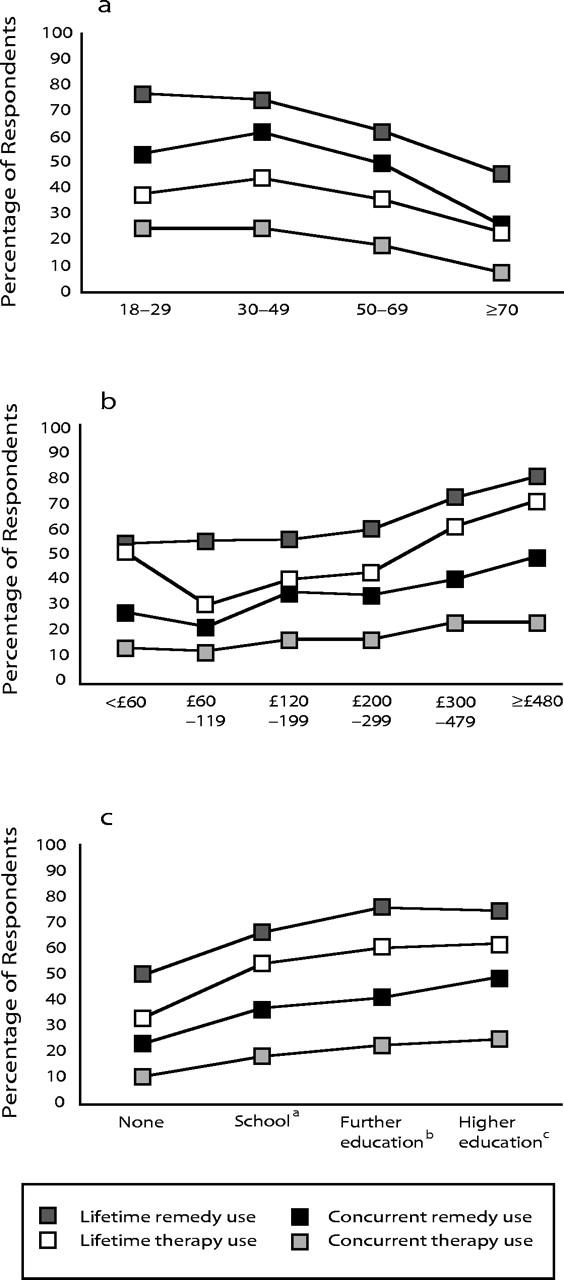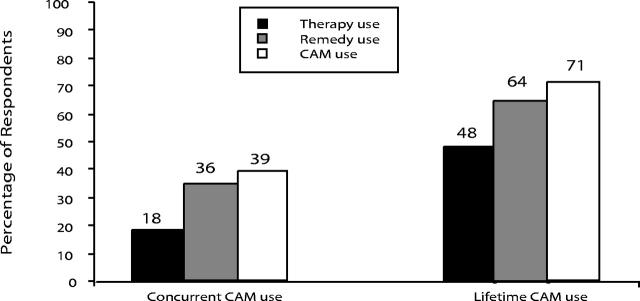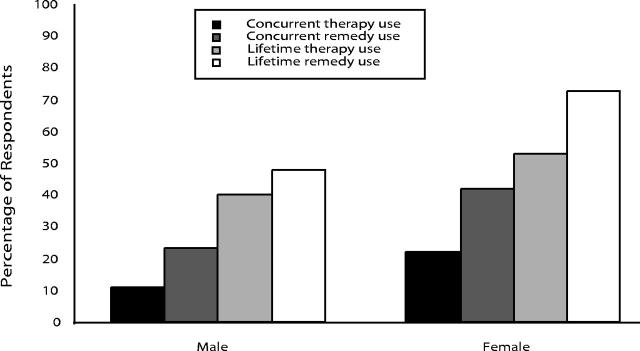The increasing use of complementary and alternative medicine (CAM) by the general population1–5 reflects a potentially positive involvement with self-care. This report describes the prevalence of CAM use in patients attending 6 different practices in Scotland. The findings indicate that CAM use in primary care attenders is even greater than in the general population.
METHODS
We selected 6 Scottish practices to represent a range of socioeconomic deprivation and rurality (2 city, 2 small-town, and 2 rural practices in the Grampian and Tayside regions), a varied list size (1474 to 10 896, average 6717), and a differing extent of provision of CAM within the practice.
Four hundred consecutive patients attending each practice in the same week in September 2000 were invited to complete a postal questionnaire. A postpaid reply envelope was included. Responses from those attending for someone else and those younger than 18 years, as well as duplicate and incomplete questionnaires, were excluded from analysis.
Complying with recommendations by Harris and Rees1 to include CAM remedies in prevalence studies, we included such remedies and gave the following definition: “Complementary and alternative medicines are: Any treatments, self-help techniques or remedies which are not normally provided by doctors and other healthcare professionals in the [National Health Service]. Many different therapies and remedies are available—such as acupuncture, aromatherapy, chiropractic, herbalism, homeopathy, hypnotherapy, osteopathy, reflexology, psychotherapy [all “therapies”] and homeopathic remedies (like arnica, chamomilla), flower essences (like Rescue Remedy, Bach Flower Essences [Nelsonbach, London, England), aromatherapy oils, herbal medicines (like St. John’s wort, echinacea, valerian), and nutritional supplements (like vitamin C, cod-liver oil, evening primrose oil, glucosamine) [all “remedies”].” Concurrent use was defined as use within the previous month.
The cover letter, signed by one of the general practitioners in each practice, said the study was designed “to find out how many of our patients are using complementary and alternative medicine. This will allow us to become more informed about the choices our patients make in their own healthcare and to provide the best service for you.” Patients were encouraged to fill in the questionnaire whether or not they had used CAM.
Two postal reminders were sent to nonresponders. Data were analysed using SPSS version 10.1 (SPSS Inc, Chicago, Ill).
RESULTS
A total of 1987 eligible patients received a postal questionnaire (patients younger than 18 years and those attending on behalf of others were excluded). Of these, 1523 (77%) responded; 348 responses were incomplete; and 1174 responses (59%) were available for analysis. Responders were older than nonresponders (mean [SD] age 54 [17] vs 43 [18] years, P < .005). Of the responders, 64.7% were female and 35.3% were male. This was representative of health center attenders in the respective practices. There was no sex difference between responders and nonresponders.
CAM Use
Of the responders, 39% reported concurrent use of CAM therapies/remedies. Of these, 18% had used 1 or more CAM therapies and 36% had used 1 or more CAM remedies. Concerning lifetime use, 71% of responders reported ever using CAM therapies/remedies, 48% of the responders had used 1 or more CAM therapies, and 64% had used CAM remedies (Figure 1 ▶).
FIGURE 1—
Concurrent versus lifetime CAM use in 1174 patients attending primary care services in September 2000.
The proportion of patients reporting concurrent CAM use varied between practices from 23% to 44%. The range for therapies was 9% to 25%, and the range for remedies was 21% to 43%. One practice consistently showed the lowest CAM use; it was an inner-city practice in a deprived area where none of the general practitioners offered CAM.
There were significant linear trends in reported CAM use, the proportion of users declining with increasing age (χ2, P < .005), lower educational attainment (χ2, P < .005), and household income (χ2, P < .005) (Figure 2 ▶). Women were using CAM significantly more than men (χ2, P < .005) (Figure 3 ▶).
FIGURE 2—

Variance in CAM use by (a) age, (b) weekly household income, and (c) educational level in 1174 patients attending primary care services in September 2000.
FIGURE 3—
CAM use by sex in 1174 patients attending primary care services in September 2000.
DISCUSSION
This study demonstrates a high level of concurrent use of CAM by patients attending primary care health centers. Lifetime CAM therapy use in primary care patients was even higher (48%) than in the general population surveyed in one of the areas of the study (Grampian) only 10 months before our study, when 41% reported lifetime use.5 Sampling bias could be responsible for this difference even though the cover letter by the general practitioner in each practice encouraged a response whether or not CAM was being used.
The influence of sociodemographic factors on CAM use was comparable to that found in other studies in the United Kingdom.2,3 Detailed comparison with other CAM use prevalence studies is difficult because varied definitions, methods, and populations have been used.
Younger patients were underrepresented among responders compared with nonresponders. This response bias may have influenced the reported rates of CAM use. However, even in the unlikely event that all nonresponders were not CAM users, the level of concurrent CAM use would still be substantial at 23%, and lifetime use at 42%.
Concurrent CAM use is common among primary care attenders. Routine recording of CAM use in the medical history is recommended to allow a more integrated approach to patients’ care.
Acknowledgments
This study received pilot funding and much practical support from Grampian Primary Care Trust and a small grant from the Highland and Island Research Network. A collaborative grant from TayREN (Tayside Research Network) covered the costs of the Tayside practices.
The authors thank all the practice managers and staff who helped with the sampling and data gathering; the Highlands and Islands Research Network for ongoing support; and Mary Bruce, Aileen Low, Bridie Fitzpatrick, Sue Pavitt, and Mike Barbour for assistance with the study.
Human Participant Protection
The study was approved by the 2 relevant local research ethics committees.
Contributors
C. Featherstone initiated the project, conducted the research, wrote the paper, and was lead researcher. D. Godden was the supervisor and revised the paper. C. Gault performed data processing and analysis. M. Emslie did the questionnaire design and analysis. M. Took-Zozaya conducted the literature review.
Peer Reviewed
References
- 1.Harris P, Rees R. The prevalence of complementary and alternative medicine use among the general population: a systematic review of the literature. Complement Ther Med. 2000;8:88–96. [DOI] [PubMed] [Google Scholar]
- 2.Thomas K. Use and expenditure on complementary medicine in England–a population based survey. Complement Ther Med. 2001;9:2–11. [DOI] [PubMed] [Google Scholar]
- 3.Ernst E, White A. The BBC survey of complementary medicine use in the UK. Complement Ther Med. 2000;8:32–36. [PubMed] [Google Scholar]
- 4.Emslie M, Campbell M, Walker K. Complementary therapies in a local healthcare setting, I: is there a real public demand? Complement Ther Med. 1996;4:39–42 [Google Scholar]
- 5.Emslie MJ, Campbell MK, Walker KA. Changes in public awareness of, attitudes to, and use of complementary therapy in North East Scotland: surveys in 1993 and 1999. Complement Ther Med. 2002;10:148–153. [DOI] [PubMed] [Google Scholar]




